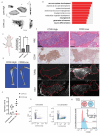This is a preprint.
Caveolin-1 regulates context-dependent signaling and survival in Ewing sarcoma
- PMID: 39713413
- PMCID: PMC11661136
- DOI: 10.1101/2024.09.23.614468
Caveolin-1 regulates context-dependent signaling and survival in Ewing sarcoma
Abstract
Plasticity is a hallmark function of cancer cells, but many of the underlying mechanisms have yet to be discovered. In this study, we identify Caveolin-1, a scaffolding protein that organizes plasma membrane domains, as a context-dependent regulator of survival signaling in Ewing sarcoma (EwS). Single cell analyses reveal a distinct subpopulation of EwS cells, which highly express the surface marker CD99 as well as Caveolin-1. CD99 High cells exhibit distinct morphology, gene expression, and enhanced survival capabilities compared to CD99 Low cells, both under chemotherapeutic challenge and in vivo. Mechanistically, we show that elevated Caveolin-1 expression in CD99 High cells orchestrates PI3K/AKT survival signaling by modulating the spatial organization of PI3K activity at the cell surface. Notably, CD99 itself is not directly involved in this pathway, making it a useful independent marker for identifying these subpopulations. We propose a model where the CD99 High state establishes a Cav-1-driven signaling network to support cell survival that is distinct from the survival mechanisms of CD99 Low cells. This work reveals a dynamic state transition in EwS cells and highlights Caveolin-1 as a key driver of context-specific survival signaling.
Figures





Similar articles
-
Targeting CD99 Compromises the Oncogenic Effects of the Chimera EWS-FLI1 by Inducing Reexpression of Zyxin and Inhibition of GLI1 Activity.Mol Cancer Ther. 2022 Jan;21(1):58-69. doi: 10.1158/1535-7163.MCT-21-0189. Epub 2021 Oct 19. Mol Cancer Ther. 2022. PMID: 34667115
-
CD99 triggering in Ewing sarcoma delivers a lethal signal through p53 pathway reactivation and cooperates with doxorubicin.Clin Cancer Res. 2015 Jan 1;21(1):146-56. doi: 10.1158/1078-0432.CCR-14-0492. Epub 2014 Dec 11. Clin Cancer Res. 2015. PMID: 25501132
-
MiR-30a-5p connects EWS-FLI1 and CD99, two major therapeutic targets in Ewing tumor.Oncogene. 2013 Aug 15;32(33):3915-21. doi: 10.1038/onc.2012.403. Oncogene. 2013. PMID: 22986530
-
CD99 at the crossroads of physiology and pathology.J Cell Commun Signal. 2018 Mar;12(1):55-68. doi: 10.1007/s12079-017-0445-z. Epub 2018 Jan 6. J Cell Commun Signal. 2018. PMID: 29305692 Free PMC article. Review.
-
EWS/FLI1 Characterization, Activation, Repression, Target Genes and Therapeutic Opportunities in Ewing Sarcoma.Int J Mol Sci. 2023 Oct 14;24(20):15173. doi: 10.3390/ijms242015173. Int J Mol Sci. 2023. PMID: 37894854 Free PMC article. Review.
References
-
- Hanahan D. & Weinberg R.A. Hallmarks of cancer: the next generation. Cell 144, 646–674 (2011). - PubMed
-
- Grobner S.N. et al. The landscape of genomic alterations across childhood cancers. Nature 555, 321–327 (2018). - PubMed
-
- Crompton B.D. et al. The genomic landscape of pediatric Ewing sarcoma. Cancer Discov 4, 1326–1341 (2014). - PubMed
-
- Grunewald T.G.P. et al. Ewing sarcoma. Nat Rev Dis Primers 4, 5 (2018). - PubMed
Publication types
Grants and funding
LinkOut - more resources
Full Text Sources
